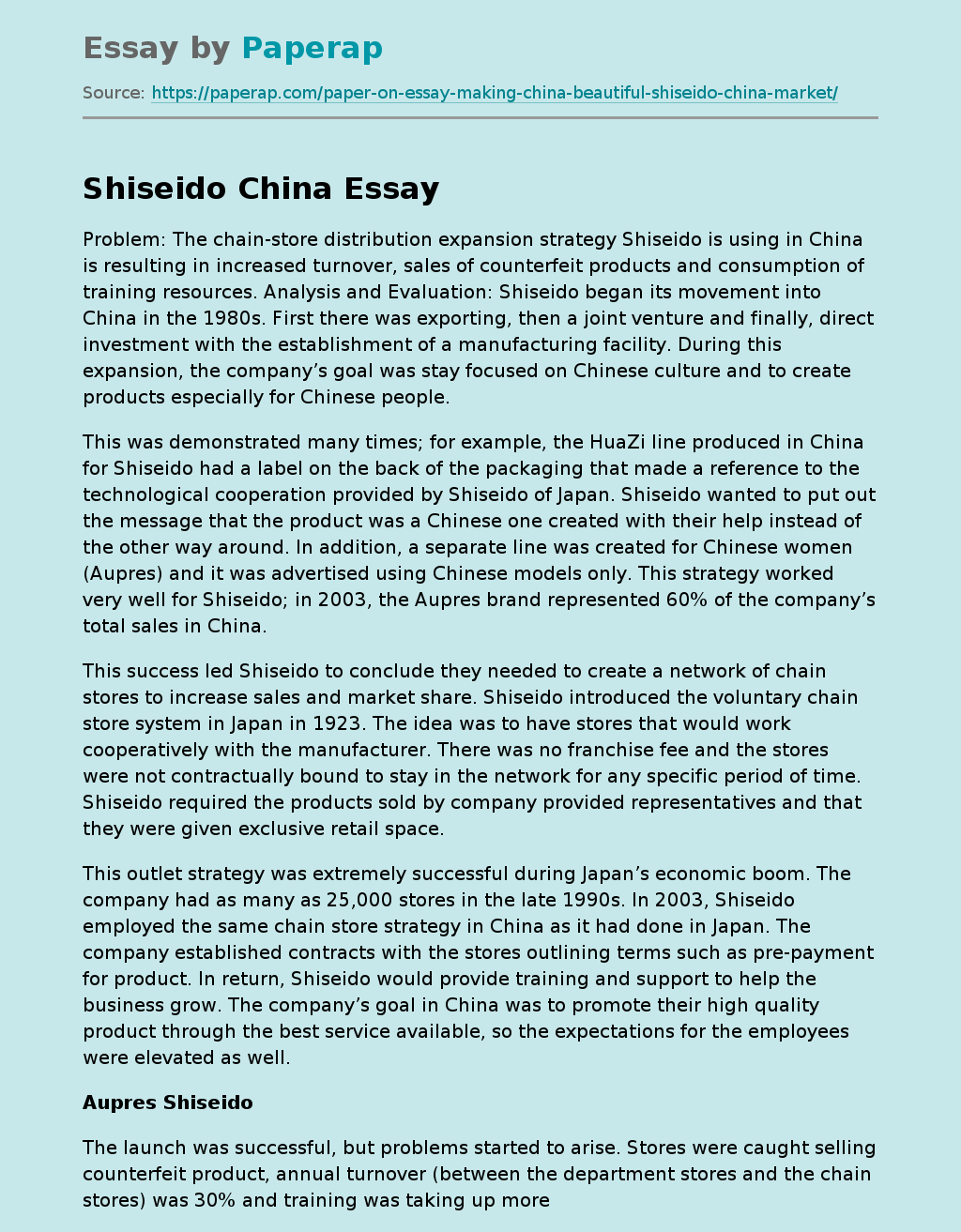Shiseido’s Store Expansion Strategy in China
The following sample essay describes the store expansion strategy that Shiseido is using in China. Read the introduction, body and conclusion of the essay, scroll down.
Problem: The chain-store distribution expansion strategy Shiseido is using in China is resulting in increased turnover, sales of counterfeit products and consumption of training resources. Analysis and Evaluation: Shiseido began its movement into China in the 1980s. First there was exporting, then a joint venture and finally, direct investment with the establishment of a manufacturing facility.
During this expansion, the company’s goal was stay focused on Chinese culture and to create products especially for Chinese people.
This was demonstrated many times; for example, the HuaZi line produced in China for Shiseido had a label on the back of the packaging that made a reference to the technological cooperation provided by Shiseido of Japan. Shiseido wanted to put out the message that the product was a Chinese one created with their help instead of the other way around.
In addition, a separate line was created for Chinese women (Aupres) and it was advertised using Chinese models only. This strategy worked very well for Shiseido; in 2003, the Aupres brand represented 60% of the company’s total sales in China.
This success led Shiseido to conclude they needed to create a network of chain stores to increase sales and market share. Shiseido introduced the voluntary chain store system in Japan in 1923. The idea was to have stores that would work cooperatively with the manufacturer. There was no franchise fee and the stores were not contractually bound to stay in the network for any specific period of time.
Shiseido required the products sold by company provided representatives and that they were given exclusive retail space.
This outlet strategy was extremely successful during Japan’s economic boom. The company had as many as 25,000 stores in the late 1990s. In 2003, Shiseido employed the same chain store strategy in China as it had done in Japan. The company established contracts with the stores outlining terms such as pre-payment for product. In return, Shiseido would provide training and support to help the business grow. The company’s goal in China was to promote their high quality product through the best service available, so the expectations for the employees were elevated as well.
Aupres Shiseido
The launch was successful, but problems started to arise. Stores were caught selling counterfeit product, annual turnover (between the department stores and the chain stores) was 30% and training was taking up more time and resources than Shiseido had anticipated. To ensure sustained success, Shiseido can address these issues a few different ways: * Fight counterfeiting through working with the Chinese government to protect intellectual property rights and to find and shut down operations making the knock-off products. Pro: The reduction of counterfeit products increases the protection of the brand. * Con: Shiseido may face resistance from the government since they are a foreign company. * Employ more control over training operations when entering into contracts with chain stores. Provide more intense support to ensure that the staff is properly trained and is on board with the company’s philosophy. * Pro: More thorough training will reduce the turnover rate. Con: This strategy will require a great amount of resources to be used prior to and during the life of the contract. * Drop the chain stores and stay with selling the product through department stores only. * Pro: Less human resources consumed for training. * Con: Shrinkage of market share due to reduced distribution channels. Recommendation: The company wants to succeed in China with a strategy that is proven in Japan, and this can be done through a training program which they tailor more towards the Chinese people.
Shiseido needs to revert back to its earlier goal of keeping the Chinese culture in mind, because this will be an effective way to teach new employees the company’s vision and values. First, research training and reward methods effective with the Chinese and use this to revise the current policies. Second, pre-screen employees using a computer test. Third, permanently relocate experienced beauty consultants to China so there is constant support within the country. These tactics will help reduce the turnover rate, and eventually reduce the amount of intense training resources needed.
Shiseido’s Store Expansion Strategy in China. (2019, Dec 05). Retrieved from https://paperap.com/paper-on-essay-making-china-beautiful-shiseido-china-market/

